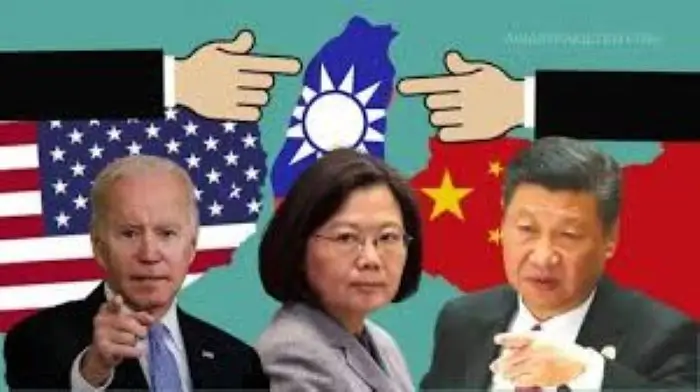On August 3, 2022, the visit of US House Speaker Nancy Pelosi to Taiwan triggered significant tensions in US-China relations. In response, China initiated exercises and “targeted military operations” in the vicinity of Taiwan. The One China principle presents a regional security threat to South Pacific Asia, and it is viewed as a potential trap that could lead both China and America towards a catastrophic world war. Following the Russian invasion of Ukraine, realists began to perceive Taiwan as the next potential conflict zone, posing a significant challenge to regional security in the South China Sea.
China, a rising global power, poses a future challenge to the United States. Taiwan holds not only vital significance for China but also strategic importance for the US. If China were to gain control of Taiwan, it would substantially enhance its capacity to exploit anti-access and area denial (A2AD) strategies, ensuring control of sea and air spaces in the near and middle seas. This would, in turn, deter or defeat any US intervention in the Western Pacific. Taiwan plays a pivotal role in China’s ambition to restore its regional hegemony, while the United States has a strategic interest in maintaining its position in the South China Sea. The ongoing tensions between the two nations threaten to undermine US naval presence in the region.
Any misjudgment by both the US and China could escalate into a full-scale war. For instance, if China incorrectly gauged Washington’s willingness to respond and attempted forced reunification with Taiwan, it could result in a devastating conflict between the US and China. Conversely, if China failed in its attempts to retake Taiwan, it would effectively signal the end of China’s ambition to dominate Asia and could spell the end of Xi Jinping’s leadership.
With Beijing’s pressure on Taiwan steadily mounting, monitoring developments across the Taiwan Strait has become more critical than ever. This article aims to delve into the One China principle from the perspective of the People’s Republic of China (PRC), the One Country, Two Systems (1C2S) formula, cross-strait relations, and Republic of China (ROC) strategies and vulnerabilities in the face of potential threats from mainland China, US interests, defense agreements, and unofficial relations with the island. Additionally, it will assess the threats posed to the South Pacific Ocean, with Taiwan at the center of the equation.
Historical Perspectives: The Origin of the Conflict
Taiwan holds immense geostrategic importance for the PRC, serving as a protective screen for China—a policy originally proposed by Admiral Shi Lang during the Qing dynasty. The PRC lays claim to Taiwan on historical grounds, considering it one of the territories of the Qing dynasty. In 1895, Taiwan became a Japanese colony as part of the spoils from Japan’s victory over China under the Treaty of Shimonoseki. Following Japan’s defeat in World War II, the Cairo Declaration, endorsed by China, the United States, and the United Kingdom, stipulated that Japan must return to China all territories it had taken, including Northeast China, Taiwan, and the Penghu Archipelago. Japan subsequently returned these Chinese territories in compliance with the Potsdam Proclamation in 1945.
The Chinese Civil War in 1949 led to the division of China into two states: the ROC (Taiwan), led by Chiang Kai-shek, and the PRC, led by Mao Zedong’s Communist regime. This division raised questions about which China should be recognized by the United Nations and how diplomatic relations with other countries should be maintained. The United States recognized the ROC (Taiwan) and entered into a mutual defense treaty with it in 1954, pledging to come to Taiwan’s defense if it were attacked. However, in 1971, the PRC replaced Taiwan within the international system due to its strategic significance and size. Taiwan was relegated to participating under special circumstances and was regarded as an unrecognized state, with only fifteen countries, including the Vatican, maintaining diplomatic relations with it.
One China: Different Interpretations and the 1992 Consensus
The ROC asserts that it is the sole representative of China, and it considers the mainland an integral part of ROC territory. The ROC claims this status due to its existence since 1912 and its role as a founding member of the United Nations. In contrast, the PRC maintains that it is the sole representative of China, citing its size, and views Taiwan as part of mainland China. The PRC contends that the KMT authorities in Taiwan have lost all legal standing to represent the Chinese people.
Both countries maintain a bilateral relationship based on the 1992 Consensus, which both the ROC and the PRC interpret in their own way, yet they agree on the One China principle. However, the Democratic Progressive Party (DPP) in Taiwan does not accept the 1992 Consensus, as it seeks to establish Taiwan as a sovereign state with its unique identity, distinct from mainland China.
One-China Principle from the PRC Perspective
The PRC had long harbored ambitions to reclaim Taiwan, but the outbreak of the Korean War forced Beijing to postpone any military campaign against the island. Just two days after the invasion of South Korea, the Truman administration called for the defense of Taiwan should China launch an attack. Another significant factor that restrained China was the unwavering American support for the containment of communism as a national security strategy. China’s aspirations were driven by its desire to become a maritime power, which necessitated establishing regional dominance in its immediate vicinity. In 1979, the PRC declared adherence to the One-China Principle as the foundation for cooperation. Consequently, most countries recognized the PRC as the sole and legitimate representative of China and acknowledged Taiwan as part of PRC territory.
The PRC envisioned Taiwan’s peaceful unification under the One Country, Two Systems (1C2S) formula, which Taiwan consistently rejected. Taiwan resisted being treated as a mere administrative region, preferring sovereignty over autonomy. Unlike Hong Kong, Taiwan was viewed by the Republic of China (ROC) as a rival Chinese state rather than a colony, and maintaining the existence of the ROC was a fundamental policy of the Kuomintang (KMT). China attempted peaceful unification through economic interdependence and cross-strait relationships, but these efforts faltered due to Taiwan’s democratization. The Sunflower Movement, in particular, demonstrated that the Taiwanese people were unwilling to submit to PRC rule.
The PRC’s greatest concerns were Taiwanese leaders who advocated for independence and promoted Taiwanese identities, such as Lee Teng Hui, Chen Shui Bian, and Tsai Ing-Wen. The PRC consistently aimed to reduce the ROC’s presence in the international system. China found it more comfortable dealing with KMT leaders than with the Democratic Progressive Party (DPP), whose primary objective was Taiwan’s independence. Xi Jinping’s non-violent coercion policy sought to weaken Tsai Ing-Wen and the DPP’s control over Taiwan but inadvertently had the opposite effect. Tsai adeptly conflated the 1992 Consensus and 1C2S, making Taiwan-US relations and democratization increasingly challenging for China. While peaceful unification remains an option for the PRC, it is not the only card up its sleeve. Any significant imbalance between the US and China or between the mainland and Taiwan could create circumstances favorable to the PRC’s hard power strategies.
One-China Policy of the USA
It is essential to distinguish between the One-China Principle and the One-China Policy, as they are not synonymous. The One-China Policy is a cornerstone of Sino-US relations and differs from the One-China Principle. The USA had maintained the One-China Policy since 1949, recognizing the ROC as the representative of China. However, during the Cold War, this stance underwent a transformation. Richard Nixon and Jimmy Carter established relations with the PRC and acknowledged Taiwan as part of the PRC.
The US policy is not aligned with the PRC’s stance. In practice, Washington maintains an unofficial relationship with Taiwan and provides arms and weapons sales to the island to bolster its defense capabilities. According to the United States, the legal status of Taiwan should be determined through negotiations between Beijing and Taipei. The US commits to come to Taiwan’s aid only in the event of a Chinese invasion, not if Taiwan declares independence.
Taiwan’s Quest for Security and Prosperity
Taiwan, also known as the Republic of China, is a relatively small island with a population of 23 million, surrounded by larger and potentially hostile neighbors. Its strategic significance is paramount, as it stands as a crucial middle link in the Asia Pacific’s first island chain and the broader security landscape of East Asia.
To address the challenge of security for this small island, Taiwan’s leaders have adopted a grand strategy, often referred to as a survival strategy. This strategy centers around seeking security through an alliance with the United States and the democratization of the country. The democratization process in Taiwan began in earnest in 1991, with roots tracing back to Sun Yat Sen’s mechanisms of direct democracy and five power systems, further developed by his successor, Chiang Kai Shek, in the 1946 constitution.
Democratization plays a pivotal role in Taiwan’s resistance to China’s claims, serving as a tool for conducting cross-strait relations. Since 1979, China has sought to bring Taiwan under its administrative control using the One Country, Two Systems (1C2S) formula. However, in 1995, Taipei firmly rejected Beijing’s 1C2S proposal, criticizing China for treating Taiwan similarly to Hong Kong and Macau, which were colonies. Taiwan, in contrast, has existed as the ROC since 1912, was an ally in World War II against Japan, and is a founding member of the United Nations. Both major political parties in Taiwan, the KMT and DPP, consistently emphasize Taiwan’s sovereignty, albeit with some differences from the mid-1990s. The DPP, in particular, has advocated for de jure independence.
During President Tsai Ing-Wen’s tenure, Beijing employed coercion without violence to handle Taiwan’s reluctance to move towards unification. While democracy is considered the best system, it is not without vulnerabilities, especially with the advent of social media as a modern warfare tool. Surveys conducted in 2010 and 2014 revealed that the Taiwanese people prefer democracy as the most suitable form of government for Taiwan. Taiwan’s political parties range from deep blue (holding traditional views that both mainland and Taiwan constitute one China) to deep green camp (advocating for de jure independence). Despite their differences, both camps share a commitment to safeguarding Taiwan’s security and autonomy, although they vary in their views regarding reliance on China or the US. Taiwan’s democracy has played a pivotal role in ensuring the security of its citizens, enabling them to have a direct say in their future rather than solely relying on their political leaders.
Taiwan faces a significant dilemma as it navigates its democratic development while simultaneously managing challenges from revisionist China. There is little room for error, and the margin for neglect is even smaller.
Taiwan’s Military Defense
The PRC is actively modernizing its military, incorporating the latest technology, advanced equipment, and cyber warfare capabilities. China is employing both soft power, through cyber and psychological tactics, and hard power, by bolstering its military capabilities, rendering Taiwan vulnerable. China has established red lines through the 2000 White Paper and the 2005 Anti-Secession Law, but this created a dilemma for Beijing. They essentially allowed Taiwan to approach but not cross those lines, displaying strategic ambiguity in the vagueness of Beijing’s laws. To employ hard power in Taiwan, China aims to make US intervention as difficult as possible.
Taiwan allocates only a small portion of its budget, approximately 11.3% on average, to defense, despite defense being a top priority for its people. The US has consistently criticized Taiwan’s low defense budget allocation in light of the increasing capabilities of the PLA. In addition to its regular budget, Taiwan’s Ministry of National Defense has sought a special budget to cover major purchases of weapon systems from the US. In response to a PLA attack, Taiwan’s overall defense concept involves buying time for US intervention through the use of sea mines and large surface ships equipped with anti-cruise missiles. According to the TNNS surveys of 2011 and 2019, the people of Taiwan are deeply concerned about the defense of their island. Concerns regarding defense strategy and limitations on military budgets only serve to strengthen the hands of potential adversaries.
Will Taiwan Be the Next Conflict Zone in South Pacific Asia?
China has emerged as a global power, surpassing the USA to become the world’s top trading nation. In 2014, the People’s Republic of China (PRC) overtook the US to become the world’s largest economy, at least in terms of purchasing power parity. This rapid economic growth has driven a substantial defense modernization effort, presenting the most significant challenge to US military supremacy in the Pacific since the end of World War II. China is upgrading its People’s Liberation Army (PLA) with cutting-edge equipment and technology, elevating it to one of the world’s most formidable military forces.
Additionally, China is establishing institutions like the Asian Infrastructure Investment Bank (AIIB) and Belt and Road Initiative (BRI) projects, viewed by the USA as potential threats to the existing global order. To establish itself as a regional power, China sought to build alliances within its home region and with the USA in Southeast Asia to counterbalance China through coalition-building. However, as per Sabastian Strangio’s analysis of Southeast Asia, seven out of ten ASEAN countries have aligned with China, influenced by various political, economic, and cultural factors.
In response to China’s rise, the Obama administration initiated a “rebalance to Asia” through the Trans-Pacific Partnership, and the Trump administration formed the QUAD and AUKUS alliances in the South China Sea to contain China in the Asia-Pacific region. The current Biden administration has also shown a commitment to come to Taiwan’s aid if attacked. Many realists, including Professor Mearsheimer, believe that war between China and the USA is likely, and one of the potential battlegrounds could be Taiwan, given the clear stances and agreements in place. The USA, as a global leader, may find it difficult to back down due to its liberal principles and the defense treaty with Taiwan.
Is Peaceful Unification or War on the Horizon?
Authoritarian states with nationalistic sentiments, like China and Russia, carry a greater risk of war. NATO’s actions in provoking Russia’s invasion of Ukraine resulted from miscalculations on both sides, highlighting the potential for similar miscalculations in Taiwan-China tensions. Some strategists argue that in an age of complex interdependence and nuclear weapons, war is unlikely. However, history shows that in World War I, Germany and Britain were economically interdependent, yet politics prevailed over economics. Similarly, while China, Taiwan, and the USA may be economically interdependent, if Taiwan declares independence, it could become politically imperative for China to resort to war, despite the strain it would put on relations with Washington and Taipei.
Another argument is that nuclear weapons make war improbable, but during the Cold War, the USA and the USSR possessed vast nuclear arsenals yet engaged in conventional conflicts. Although neither country, especially China, desires a conflict with the USA, as its primary objective is coercion without violence through cyber and hybrid attacks in the Taiwan Strait, China recognizes that a prolonged delay in acquiring the territory would benefit Taiwan. Consequently, some strategists predict a confrontation between great powers, possibly until 2049, over this issue and other regional disputes, such as Japan’s disputed islands.
Conclusion
Taiwan holds significant importance for both China and the USA, making it a prize in the ongoing power politics. The prospect of war over Taiwan is a distinct possibility, persisting until 2049. This situation constitutes a perilous trap for both China and the USA, carrying the potential for a global conflict akin to World War III, resulting in a severe worldwide economic recession. Both nations are engaged in a relentless technological, cyber, and military arms race. Given these circumstances, the regional threat to Southeast Asia’s security and the world order is palpable. It is incumbent upon both nations to exercise every possible measure to avoid war, for the benefit of all humanity.










